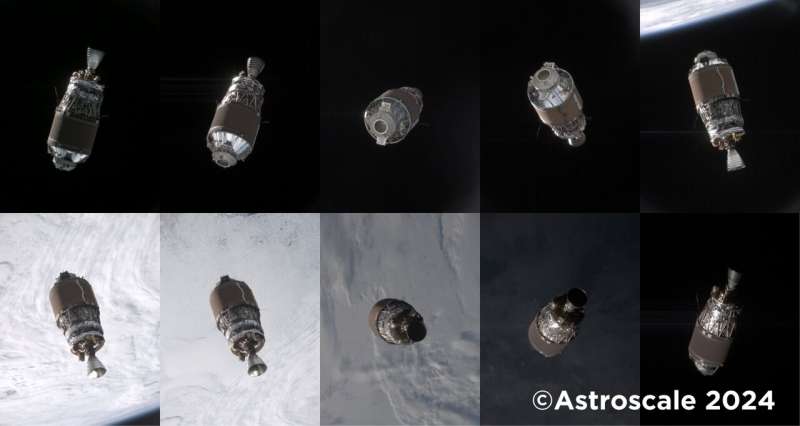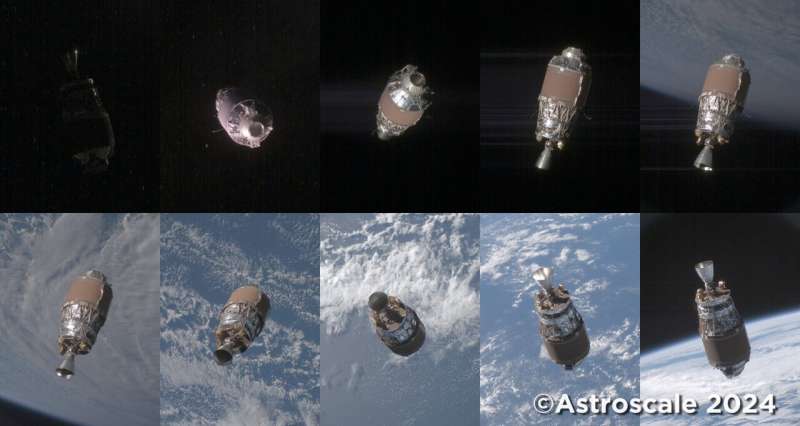This article has been reviewed according to Science X's editorial process and policies. Editors have highlighted the following attributes while ensuring the content's credibility:
fact-checked
proofread
Fly-around observation images of space debris released

The Japan Aerospace Exploration Agency (JAXA) has advanced the Commercial Removal of Debris Demonstration (CRD2) Phase I project. Under this initiative, the demonstration satellite ADRAS-J, developed by Astroscale Japan Inc., has successfully captured images of space debris, a non-cooperative target, through "Fly-around observation." These images have now been released by Astroscale Japan Inc.
The fly-around observation service is the third of the four services required by JAXA in CRD2 Phase I. This service involves pointing a camera at the target debris, maintaining a constant distance from it, and orbiting around the target debris to capture images from different directions.
On July 15 and 16, 2024, ADRAS-J, operated by Astroscale Japan Inc., successfully carried out the fly-around observation service in compliance with the safety requirements set by JAXA (JERG-2-026 Safety Standards for On-Orbit Servicing Missions). The distance to the target debris was approximately 50 meters. As a result, a series of images shown in Figures 1 and 2 were successfully captured. In these images, the target debris appears almost stationary with the PAF pointing in the nadir direction, while ADRAS-J moves around and takes images.

The specifications for the fly-around observation service are designed to obtain high-quality images and sufficient data to reveal the motion, damage, and degradation of long-orbiting debris, which is globally scarce information. These specifications have been carefully developed based on JAXA's technical expertise, ensuring their feasibility. By providing this service, the contracted company acquires Rendezvous and Proximity Operations (RPO) technologies applicable to a wide range of on-orbit services, including active debris removal.
In on-orbit services, it is necessary to control the relative position and attitude of the servicer to get around to a specific part of the target to observe or perform some task on it.
There are several technical challenges in achieving this for non-cooperative targets, including the detailed shape and surface reflectance of the real target object, which is not known in advance, the changing visibility of the target object, and the influence of Earth-reflected light, which disturbs the navigation sensor (the so-called earth background problem in non-cooperative relative navigation).
This is a technically challenging mission, as the servicer spacecraft must overcome these challenges for relative navigation while achieving highly accurate relative six-degree-of-freedom control.
The successful safe completion of this service by ADRAS-J marks a steady step toward achieving CRD2's two objectives: acquiring debris removal technology to improve the increasingly serious space debris problem and enhancing the competitiveness of Japanese companies in the on-orbit services market.
The images in Figures 1 and 2 allowed us to see the surface appearance of the entire target debris, not just the sides visible during the previous fixed-point observation service. Additionally, the PAF of the upper stage of the rocket and its surroundings, which are the target part to be grabbed during CRD2 Phase II, were identified in detail after 15 years in orbit.
The string-like objects observed on either side of the body are presumed to be surface protection tapes, also seen in the launch operation images. These observations provide critical insights for designing and validating the capture system for the upcoming CRD2 Phase II.
Astroscale Japan Inc. will continue to operate ADRAS-J and will first carry out Astroscale missions, which are planned and carried out by the company itself. Next, as the last of the four "services" required by JAXA, the mission termination service (transfer to a safe orbit without colliding with the target) will be carried out.
JAXA has provided extensive technical advice, testing facilities, and research intellectual property, focusing on on-orbit rendezvous, supporting ADRAS-J's development and operation. Moving forward, JAXA will continue to provide technical support for ADRAS-J operations and conduct a detailed analysis of the obtained images.
Provided by JAXA





















